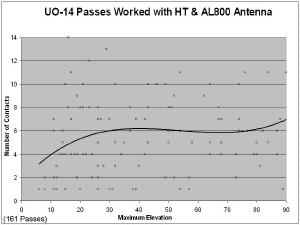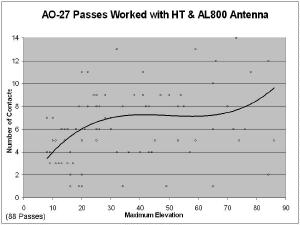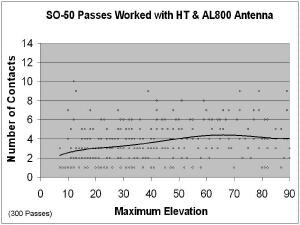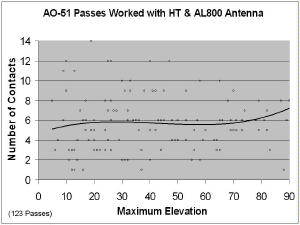HT and AL800 Antenna – An
Excellent Portable Satellite Station
Allen F. Mattis, N5AFV, [email protected]
(Published in The
AMSAT Journal, March/April 2005 (Volume 28, No. 2), pp. 21-23)
Abstract
Satellite demonstrations at ham fests and other similar events almost always draw a group of interested onlookers who are quite often surprised to learn that it doesn’t take expensive or elaborate equipment to make satellite contacts. My preferred personal choice for portable FM LEO satellite operation is an HT with a Premier (Pryme) AL800 antenna. The FM LEO satellites are well suited for operators with small portable satellite stations, and as a result, these popular satellites allow the activation of many rare maidenhead grid squares. With today’s FM satellites it is possible to work a satellite pass from almost any location that provides the operator with a clear line-of-sight window to the bird.
Use of HT’s
to Work the FM Satellites
The amateur radio satellite literature contains a number of
articles describing portable operation by various operators on the FM LEO
satellites. While a few operators
like Glasbrenner (2005) describe operating with larger radios, most portable FM
LEO satellite operation has been done with dual-band HT’s. MacAllister (1997 and 2000), Devlin
(Anonymous, 2000) and Mattis (2003) have described their operations using
HT’s on cruise ships. Soifer
(1999) operated in the
Equipment Options
The kind of portable operation on the FM satellites that I enjoy is being able to operate wherever I travel. That kind of operation requires small light-weight equipment. A dual-band HT that has dual reception (both bands at the same time) is ideal because it allows the operator to hear himself in the downlink. Most of these units have a high-power capability of five watts. I use an Icom W32A HT; however, any other dual-band dual reception HT that covers the satellite bands may also be used.
The antenna is very important, because as we all know if you can’t hear them you can’t work them. The small rubber duck antennas that come with an HT do not usually have enough gain to hear the bird very well. The Arrow beam and similar antennas have excellent gain however, they are a little large to carry around, take time to assemble, and draw attention to the operator. A middle group of antennas, consisting of long or extended rubber ducks and telescoping antennas, provide more gain on receive than standard rubber ducks, are very compact, and require no time to assemble. It is this middle group of antennas that suit my operating needs.
The extended rubber ducks and telescoping antennas have
enough gain on the downlink to allow the operator to hear most of the satellite
pass, and the gain on the uplink signal is strong enough to get into the bird
if the operator does not double with a stronger station. One advantage of these antennas has been
described by Soifer (1999) as “Armstrong X, Y and Z axis
rotation.” The user has
the ability to orient the antenna in any position to match any possible
polarity shifts of the satellite’s signal. The MFJ-1717 16-inch rubber-coated
dual-band antenna, which was used by Soifer when he operated in the
I like to wear a headset with a boom microphone when I operate with my HT and AL800 antenna because it allows me to hear myself in the downlink. My usual choice of headset is an MFJ-288I. The headset puts the sound directly into my ear, which makes it easier to hear the satellite if it is windy. Also, no matter what position the HT is in, I am able to hear the satellite and speak into the microphone. If, however, I were doing a satellite demonstration at a ham fest or similar event, I would want to use equipment where the observers could hear the satellite.
There are times when you may not want to call attention to
yourself, and the headset is ideal for those situations. My occasional trips to
At the
passes with my HT & AL800. Note DPS
officer present in lower left.
Operating Hints from the
Literature
The most difficult aspect of working the FM satellites with an HT and extended rubber duck or telescoping antenna is being able to hear the satellite. Bob Bruninga devised a homebrew reflector built from wire mesh that focuses the satellite’s signal on an HT and greatly improves the ability to copy the downlink, even with a standard rubber duck antenna (Duey, 2001).
Duey (2001) described what he termed the “rental car” technique, which improves the performance of an HT with an extended rubber duck or telescoping antenna for passes of thirty degree elevation or higher. In this technique, a car is parked in a north-south direction with the hood facing the horizon where the satellite will first appear. As the satellite comes up over the horizon, the HT is held about four inches in front of the hood. Reflections off the hood improve performance of the HT until the satellite reaches an elevation of about fifteen degrees. The HT is then moved to between the hood and windshield. As the satellite reaches even higher elevation, the HT is held vertical with the antenna connector at about roof level. Toward the end of the pass the HT is moved to the trunk area. Duey reported that this technique worked well with UO-14, but only showed marginal signal improvement with AO-27.
Most operation on the FM satellites with an HT and extended rubber duck or telescoping antenna is done in the open without the benefit of a manmade reflector to focus the satellite’s signal on the HT’s antenna. Duey (2001) observed that on passes of ten to thirty degrees in elevation local objects and terrain could be used to boost signals if the HT was inverted or held upside down with the antenna pointing toward the ground. Clarke (2004) recommended tilting the HT about the same amount from vertical as the satellite’s elevation to improve reception. If you are facing the satellite you tilt the antenna downward, and if your back is toward the satellite you tilt the antenna upward.
Scott Medbury, KD5FBA, dressed in Scottish attire for his friend’s wedding,
works a satellite pass with his Icom W32A HT and AL800 Antenna.
Operating Hints from Experience
The technique I developed by making over three thousand satellite contacts with my HT and AL800 antenna agrees for the most part with the observations of Duey and Clarke. When the satellite is low to the horizon, the downlink signals often reflect off the ground. Holding the HT upside down with the antenna pointing toward the ground greatly improves the reception of the satellite when it is at low elevations. The lower the satellite is, the closer to vertically upside down I hold the HT. As the satellite climbs higher, above about 20 degrees elevation, I begin to hold the HT as described by Clarke, at angle of about the same number of degrees from vertical as the satellite’s elevation. It is necessary to move the antenna around (Soifer’s Armstrong X, Y and Z axis rotation) as the polarity of the downlink signal shifts to maximize the signal strength, and it is sometimes necessary to go back to holding the HT with the antenna pointing toward the ground for brief periods. If the satellite is at an extremely high elevation angle of 75 degrees or greater, holding the HT horizontal may provide maximum signal strength. As the satellite begins to drop toward the horizon, the sequence is repeated in reverse order, ending with the HT being held vertically upside down as the satellite drops below the horizon.
The lowest elevation pass on which I have made contacts with my HT and AL800 antenna was a five degree elevation pass of AO-51. For other FM satellites the lowest elevations with contacts were six degrees on UO-14, seven degrees on SO-50 and eight degrees on AO-27. In general, it is usually difficult to make contacts with an HT and AL800 antenna on satellite passes with elevations less than about ten or twelve degrees.
The effectiveness of an HT and AL800 antenna varies somewhat from satellite to satellite, probably due to differences in the antennas on the satellites, and due to the individual characteristics of each bird. It is very seldom that I do not make at least one contract on a satellite pass using my HT and AL800. I have found that AO-27 is the easiest of the current FM satellites to work with this equipment, and SO-50 is the most difficult.


Results of working 300 SO-50 passes, 123 AO-51 passes, 161 UO-14 passes and 88 AO-27 passes
with an Icom W32A HT and AL800 antenna.
Conclusion
An HT with a Premier (Pryme) AL800 telescoping antenna makes an excellent portable station to work the FM LEO satellites. The addition of a headset with a boom microphone allows full duplex operation and gives the operator the ability hold the HT and antenna in almost any position and still be able to hear the bird and speak into the microphone. This equipment makes it possible to work today’s FM LEO satellites from almost any location.
References
Anonymous, 2000,
(Volume 23, Number 4), p 26.
Clarke, Emily, 2004, 12 Suggestions for Success Working AMSAT-OSCAR 51 (Echo) on
a Handheld Transceiver, The AMSAT Journal, Novmber/December (Volume 27,
Number 6), pp 24-25.
Duey, Charles, 2001, Tricks, Hints and Tips for the Portable Satellite Operator, QST,
March, pp 55-57.
Glasbrenner, Andrew, 2005, A Short Introduction to Using Your FT-817 and Arrow for
SSB Satellite Demonstrations, The AMSAT Journal, January/February
(Volume 28, Number 1), p 8.
MacAllister, Andy, 1997, Cruising for AO-27 on the Carnival Sensation, 73 Amateur
Radio Today, HAMSATS column, March, p 60.
MacAllister, Andy, 2000, Cruising for Satellites, 73 Amateur Radio Today – Special
HAMSATS issue, October, pp 22-28.
Mattis, Allen, 2003, Prior planning - key to a successful DX cruise, The AMSAT Journal,
May/June (Volume 26, No. 3), pp 24-26, (reprinted from Worldradio, 2002, April,
pp 18-21).
Sheets, John, 1999, AO-27 Satellite Operations are Possible on a Small Budget, The AMSAT
Journal, May/June (Volume 22, Number 3), pp 22-23.
Soifer, Ray, 1999, AO-27: An FM Repeater in the Sky, The ARRL Satellite Anthology,
pp 4.11-4.12, (reprinted from QST, January, 1998, p64).
Postscript to HT and AL800 Antenna
– An Excellent Portable Satellite Station
Allen F. Mattis, N5AFV, [email protected]
(Published in The AMSAT Journal, May/June 2005 (Volume 28, No. 3), p. 17)
Introduction
My article about using an HT and AL800 as a portable satellite station (Mattis, 2005) resulted in many satellite operators commenting to me about how surprised they were that I was able to work low elevation passes with the small AL800 antenna. Since receiving those comments, I have been making an effort to work low elevation passes of FM LEO satellites whenever I can.
Discussion
At the time I wrote the article (Mattis, 2005), the lowest elevation pass on which I had made contacts with my HT and AL800 antenna was a five degree elevation pass of AO-51. This pass was worked while I was at sea on a cruise ship, and I had a totally clear horizon down to sea level. Also, the fact that I was located in a rare Maidenhead grid square caused many stations to attempt to work me thus making it easier to make contacts.
My lowest elevation passes with contacts on other FM LEO satellites were six degrees on UO-14, seven degrees on SO-50 and eight degrees on AO-27. The graphs where I plotted the number of contacts versus maximum degrees of elevation for passes of each satellite suggested that it was easier to make contacts on AO-27 than the other FM LEO satellites. I decided to try to work very low passes of AO-27 using an HT and AL800 antenna.
On May 31, 2005, I had the opportunity to work a four degree maximum elevation east pass of AO-27 at 2120 UTC. I had solid copy on the bird for approximately three minutes, and made contacts with VE3OBP, N4QWF and KC8ZFN. On June 7, 2005, at 2122 UTC on another 4 degree maximum elevation east pass of AO-27, I was able to work N5UXT. I worked K9OIM on a six degree maximum elevation pass of AO-51 on June 8, 2005, and on June 14, 2005, I worked N4QWF on a five degree maximum elevation pass of AO-27. I did try working a three degree maximum elevation east pass of AO-27 and I heard the bird for about 20 seconds but was not able to make any contacts because of tall buildings on the horizon.
Conclusion
Using an HT with the small telescoping AL800 antenna provides exceptional portability and allows amateur radio operators to take a portable satellite station with them almost anywhere they go. It is not surprising that the AL800 antenna is becoming popular with those who operate FM LEO satellites.
References
Mattis, Allen, 2005, HT and AL800 Antenna – An Excellent Portable Satellite Station: The
AMSAT Journal, March/April (Volume
28, No. 2), p. 21-23.
E-mail - [email protected]


